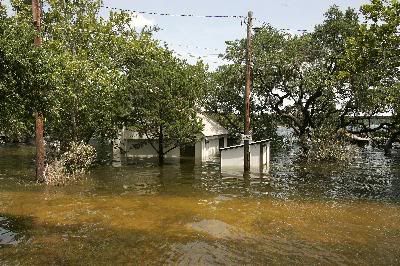When it rains, it pours -- thanks to global warming
 Storms bringing heavy rainfall are now 24 percent more frequent across the United States today than they were 60 years ago, including in many areas of the South. That confirms scientists' warnings that a warming global climate will bring more extreme weather events, from prolonged droughts such as the one currently afflicting the Southeast to more heavy rainstorms.
Storms bringing heavy rainfall are now 24 percent more frequent across the United States today than they were 60 years ago, including in many areas of the South. That confirms scientists' warnings that a warming global climate will bring more extreme weather events, from prolonged droughts such as the one currently afflicting the Southeast to more heavy rainstorms.
The storm findings come from a new report by Environment America, which looked at trends in the frequency of big rain and snow events across the continental United States from 1948 to 2006.
"This report demonstrates that we are already seeing the effects of global warming even with a relatively small increase in temperatures," said Dr. William Moomaw, director of the Center for International Environment and Resource Policy at The Tufts University Fletcher School and a member of the Nobel Peace Prize-winning Intergovernmental Panel on Climate Change. "The projected increases are much greater, and the impacts are already much more than was predicted. It is imperative that we begin now to reduce the emissions of heat trapping gases to avoid serious and uncontrollable damage."
While New England and the Mid-Atlantic region experienced the biggest increases in storms with heavy precipitation at 61 and 42 percent respectively, the frequency of such strong storms has also increased significantly in many Southern states, including Louisiana (52 percent), West Virginia (40 percent), Alabama (35 percent), Mississippi (34 percent), Texas (28 percent), Virginia (25 percent), Tennessee (21 percent), Kentucky and North Carolina (16 percent), and Georgia and South Carolina (14 percent).
While the frequency of such storms decreased in Arkansas (by 1 percent) and Florida (by 12 percent), at least one Florida community experienced significant increases in heavy rainfall events: the Sarasota-Bradenton metro area, with a 95 percent increase. Other Southern metro areas with big increases in extreme rainstorms included Jackson, Miss. (187 percent); Baton Rouge, La. (110 percent); the Augusta-Aiken area in Georgia and South Carolina ( 84 percent); Mobile, Ala. (80 percent); and New Orleans and El Paso, Texas (51 percent).
The Senate Environment and Public Works Committee is expected to begin work today on historic legislation to address global warming -- the Lieberman-Warner Security Act of 2007 (S. 2191), sponsored by Sens. Joseph Lieberman (I-Conn.) and John Warner (R-Va.). The bill would cap greenhouse gas emissions and reduce them by 60 percent by 2050 through a system under which companies are assigned pollution credits that can be bought, sold and traded. By midday yesterday, Republican critics of the measure led by global warming skeptic Sen. James Inhofe (R-Okla.) had filed more than 150 amendments that would weaken the bill's efforts to cut greenhouse gas emissions.
Meanwhile, Environment America Director Anna Aurilio says the bill's current pollution reduction targets fall short of what's necessary to avoid the worst effects of global warming. At the same time, the legislation subsidizes dirty and dangerous energy sources. For Environment America's analysis of the legislation and proposed amendments, click here.
According to the latest science, the United States must reduce its total greenhouse gas emissions by at least 15 percent by 2020 and by at least 80 percent by 2050 in order to stave off the worst effects of global warming.
(Photo of July 2007 Texas flooding by Bob McMillan for FEMA)
Tags
Sue Sturgis
Sue is the former editorial director of Facing South and the Institute for Southern Studies.
